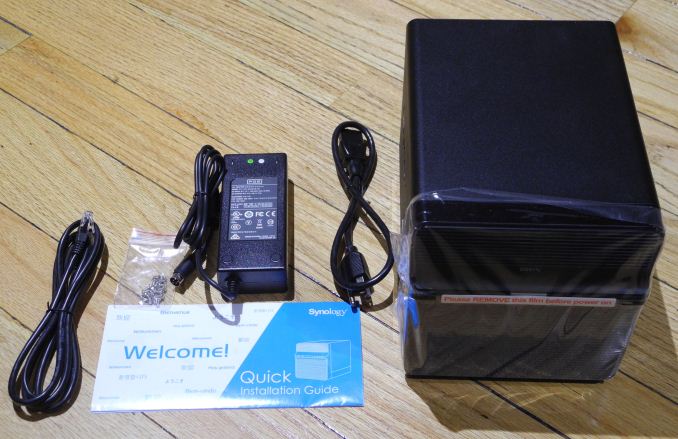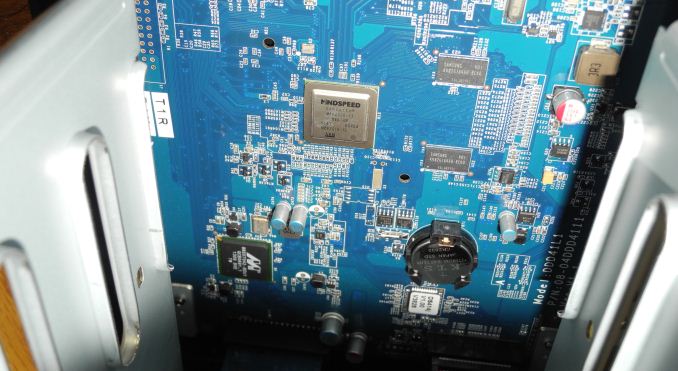Synology DS414j: An Ideal Backup NAS
by Ganesh T S on July 10, 2014 9:00 AM ESTHardware Platform & Usage Impressions
The industrial design of almost all Synology NAS models strike the perfect balance between form and function. The hot-swap bays are easily accessible, the drive bay mechanism works great and the cooling system ensures adequate ventilation for the hard drives. Synology's j-series, however, doesn't support hot-swapping the disks in the specifications (mainly as a feature to cut down and a way to differentiate between the j- and the non-j models). In order to 'enforce' this, the disks had to be placed in a manner such that the user wouldn't accidentally remove / replace / hot-swap one of the disks. This is one of the primary reasons for the chassis design of the j-series being quite different.
The contents of the DS414j package are provided below:
- Synology DS414j chassis
- 2M Cat 5E Ethernet cable
- 90 W (12V @ 7.5A) external power supply with US power cord
- Getting Started guide
- Screws for hard disk installation
The main chassis looks like an antique box. While some tend to like the design, others prefer the simple and elegant traditional box with easily accessible drive bays on the front side. On the rear side of the unit, we have four screws which can be easily removed to bring down the hinged plate on which the fan is mounted. This exposes the motherboard at the bottom and the metal housing for the drives. Synology makes hot-swap virtually impossible by having mounting screws on the metal housing in addition to the screws for the plastic drive trays.
Platform Analysis
On the motherboard side of things, we can see the Mindspeed Comcerto 2000 SoC right in the middle with no heat sink. Towards the bottom left, we have a Marvell 88SX7042 SATA controller.
We already looked at the block diagram of the SoC in our launch piece on the 414j. The available high-speed I/Os include 2x SATA2, 2x PCIe 2, 1x USB 3.0 and 1x USB 2.0. Three GMACs are present, but the 414j uses only one of them for its sole RJ-45 port (with the help of a Realtek RTL8211E GbE PHY connecting through the RGMII interface). The Marvell 88SX7042 is present in almost all 4-bay NAS units of this generation and the DS414j is no exception. It is a 4x SATA II to 1x PCIe bridge that connects the drives in all the four bays to the SoC. The rest of the ports on the unit (1x USB 2.0 and 1x USB 3.0) come directly off the SoC.
Setup and Usage
After connection to the network, the unit obtains a DHCP address (even in diskless mode) and could be setup using the web UI at http://<DS414j-IP>. The determination of the IP itself could be done through Synology's helper site, find.synology.com. This service occasionally finds existing Synology units in the network too.
The setup process is straightforward. At least one of the bays needs to be populated. We chose to use the web interface (rather than the Synology Assistant tool) to initialize the NAS. The firmware (Synology Disk Station Manager - DSM) can be uploaded from a local file in this process. Basic administration settings are also configured. After a restart, the rest of the configuration is handled through the DSM web UI.
Upon logging into a freshly installed DSM, the user is provided with various options to aid in setup of external access to the NAS. Synology allows its users to create a MyDS account on their servers. The NAS units themselves are provided with a unique 'QuickConnect' ID. A MyDS account can have multiple QuickConnect IDs associated with it. The combination of this ID and a MyDS account helps Synology operate a relay service for access to the NAS from an external network. Users can opt to not register for these, but still enjoy external access if they forward the appropriate ports on their router.
The combination of a desktop-style interface and a multi-tasking UI with support for desktop widgets makes DSM a pleasure to use. Backing up the eye-candy is a rock-solid Linux-based storage management system and a wealth of applications (both Synology-created and third-party developed). Exploring all the features of DSM 5.x deserves a separate piece by itself. However, we will take a slightly different approach. In the DS214play review, we focused on the external access and multimedia features. In this, we will talk about the cloud / NAS backup and synchronization capabilities after discussing the benchmark results.
Our testing sequence started with the insertion of a single disk and configuring it in Synology Hybrid RAID (SHR). For a single disk, it is effectively a JBOD configuration, but the addition of a second disk triggers a migration to RAID-1. Even though the unit officially doesn't hot-swap, we were able to add and replace disks with the unit powered on. While migrating to the new RAID level on the DS414j, the data remained online and the process got done without any hitch. We tested RAID-5 rebuild by yanking out a disk during operation and re-inserting it (after externally formatting the drive). The rebuild process was also uneventful. On the whole, we were very satisfied with the unit's handling of storage operations (including handling of disk failures)




































41 Comments
View All Comments
edzieba - Thursday, July 10, 2014 - link
Why RAID10 rather than RAID6 (or RAIDZ2)? Surely the superior robustness is worth the minimal performance reduction?JimmaDaRustla - Thursday, July 10, 2014 - link
RAID 6 has no space efficiency over RAID 1+0 in a 4 drive setup. It also has no write performance gains, especially when considering it needs to calculate the parity blocks. And read speed is theoretically slower since RAID 1+0 has two sets of data to work off of. And lastly, if a drive dies, RAID 1+0 has no performance decrease, but RAID 6 would take a hit because it would need to calculate blocks using the parity.JimmaDaRustla - Thursday, July 10, 2014 - link
Edit: I'm amateur though, not sure if there is more to RAID 6, but in a 4 drive setup, I would go with RAID 1+0bernstein - Thursday, July 10, 2014 - link
RAID6 in a 4bay home nas is just asking for unnecessary trouble. However RAID6 can take the death of any two drives, whereas in RAID 1+0 if the wrong two drives fail your data is toast. But if you value your data enough to invest in a NAS with RAID1/5/6 you actually want RAIDZ2.piroroadkill - Thursday, July 10, 2014 - link
4-bay NAS is such a pain in the ass! For years I've seen 4-bays across the board, but that's never been enough.DanNeely - Thursday, July 10, 2014 - link
Because 2/4 bay units are enough for the vast majority of home users.Gunbuster - Thursday, July 10, 2014 - link
Also no ARM chip is going to keep up with the overhead of more drive bays. You get a real server or SAN for that.Samus - Thursday, July 10, 2014 - link
Not necessarily CPU limited. I have an Areca RAID controller with 8 SAS channels (and up to three arrays) on an XSCALE 800MHz CPU with good overall performance. It's running two arrays in a server (one array is three S3500 SSD's, another is five 900GB SAS drive.)I simulated a drive failure by pulling power from one of the 900GB SAS drives, wiping it, and reattaching it while in Server 2012 and it rebuilt the array (3.5TB, 2TB of data) in ~10 hours while maintaining high availability. A tax system running in Hyper-V and the 50GB exchange store resided on that array while being rebuilt.
M/2 - Thursday, July 10, 2014 - link
I agree. I've never understood I would want to go thru the trouble of configuring NAS and then live slow throughput. Especially when I can connect a USB3 RAID to any cheap server (I've got a $600 Mac Mini) and get better performance. I get 104 MB/s on my external drive over the network vs. 240 MB/s locally. That's over gigabit ethernet, I get about 23-30 Mb/s on 5 Ghz Wifi-N. But, I'm just a home user, what do I know? Maybe when you get many users, there's an advantage, but look at how slow!DanNeely - Thursday, July 10, 2014 - link
Feeding multiple computers is one of the primary reasons to use a NAS instead of just connecting more drives locally.